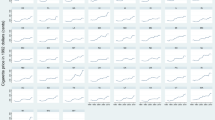Abstract
This paper examines the impact of the large increases in cigarette prices after the Master Settlement Agreement on cigarette consumption among smokers by estimating a dynamic panel data model. I use system generalized method of moments estimator with fixed effects to address the unobserved heterogeneity and the initial conditions problem. I find that older smokers (aged 51 and older) are virtually unresponsive to price changes, and younger smokers (aged 50 and younger) are more price sensitive; women smokers might be more price responsive; and the overall estimated price elasticity for the full sample of smokers is −0.26. In addition, smoke-free air laws do not show significant effects.


Similar content being viewed by others
Notes
Source: Center for Disease Control and Prevention (CDC). “Tobacco Use: Targeting the Nation’s Leading Killer at a Glance 2011.” http://www.cdc.gov/chronicdisease/resources/publications/AAG/osh.htm. Accessed on April 21, 2014.
Chaloupka and Grossman (1996).
See Orzechowski and Walker (2009).
Adjusted to 1999 dollars.
In this paper, smokers are defined as the individuals who report smoking at least one cigarette per day on average. Because non-smokers should not be affected by increases in cigarette prices, they are excluded in this study.
See Chaloupka and Warner (2000).
The dependent variable does not include zeros because smokers smoke at least one cigarette per day on average.
See Orzechowski and Walker (2009).
See Nickell (1981).
See Bond (2002).
These are used as IV style instruments in addition to the GMM style instruments. See Roodman (2006).
Z di is the instrument matrix for the differenced equation for each individual; Z li is the instrument matrix for the level equation for each individual; Z si is the instrument matrix for the system of equations for each individual.
Z s , ΔU i and U i are stacked matrices across individuals.
Balanced panels are used.
Windmeijer finite-sample corrected standard errors are reported. See Windmeijer (2005).
Although the validity of this finding is weakened by the failure in the autocorrelation test, the Difference-in-Hansen test suggests that the instruments are exogenous.
References
Arellano, M., & Bover, O. (1995). Another look at the instrumental-variable estimation of error-components models. Journal of Econometrics, 68, 29–52.
Becker, G., Grossman, M., & Murphy, K. (1994). An empirical analysis of cigarette addiction. The American Economic Review, 84(3), 396–418.
Becker, G., & Murphy, K. (1988). A theory of rational addiction. The Journal of Political Economy, 96(4), 675–700.
Blundell, R., & Bond, S. (1998). Initial conditions and moment restrictions in dynamic panel data models. Journal of Econometrics, 87, 115–143.
Boltagi, B., & Levin, D. (1986). Estimating dynamic demand for cigarettes using panel data: The effects of bootlegging taxation and advertising reconsidered. The Review of Economics and Statistics, 68(1), 148–155.
Bond, S. (2002). Dynamic panel data models: A guide to micro data methods and practice. Institute for Fiscal Studies, WP09/02.
Bond, S., & Windmeijer, F. (2002). Finite sample inference for GMM estimators in linear panel data models. Institute of Fiscal Studies, WP02/x.
Chaloupka, F. (1990). Men, women, and addition: The case of cigarette smoking. NBER working paper no. 3267.
Chaloupka, F. (1991). Rational addictive behavior and cigarette smoking. The Journal of Political Economy, 99(4), 722–742.
Chaloupka, F. J., & Grossman, M. (1996). Price, tobacco control policies and youth smoking. NBER working paper no. 5740.
Chaloupka, F. J., & Warner, K. E. (2000). The economics of smoking. In A. J. Cuyler & J. P. Newhouse (Eds.), The handbook of health economics (Vol. 1B, pp. 1539–1627). Amsterdam: Elsevier.
Chamberlain, G. (1984). Panel data. In Z. Griliches & M. Intriligator (Eds.), Handbook of econometrics (Vol. 2, pp. 1247–1318). Amsterdam: North Holland.
Cheng, K., & Kenkel, D. (2010). U.S. cigarette demand: 1944–2004. The B.E. Journal of Economic Analysis and Policy, 10(1), 1–21.
Colman, G., & Remler, D. (2008). Vertical equity consequences of very high cigarette tax increases: If the poor are the ones smoking, how could cigarette tax increases be progressive? Journal of Policy Analysis and Management, 27(2), 376–400.
DeCicca, P., & Mcleod, L. (2008). Cigarette taxes and older adult smoking: Evidence from recent large tax increases. Journal of Health Economics, 27, 918–929.
Farrelly, M., Brady, J., Pechacek, T., & Woollery, T. (2001). Response by adults to increases in cigarette prices by sociodemographic characteristics. Southern Economic Journal, 68(1), 156–165.
Glied, S. (2002). Youth tobacco control: Reconciling theory and empirical evidence. Journal of Health Economics, 21, 117–135.
Hersch, J. (2000). Gender, income, levels, and the demand for cigarettes. Journal of Risk and Uncertainty, 21(2/3), 263–282.
Lewit, E. & Coate, D. (1982). The potential for using excise taxes to reduce smoking. NBER working paper no. 764.
Nickell, S. (1981). Biases in dynamic models with fixed effects. Econometrica, 49(6), 1417–1426.
Orzechowski, W., & Walker, R. (2009). The tax burden on tobacco: Historical compilation. Virginia: Arlington.
Picone, G., Sloan, F., & Trogdon, J. G. (2004). The effect of the tobacco settlement and smoking bans on alcohol consumption. Health Economics, 13(10), 1063–1080.
Roodman, D. (2006). How to do xtabond2: An introduction to “Difference” and “System” GMM in Stata. Center for global development working paper no. 103.
Stehr, M. (2007). The effect of cigarette taxes on smoking among men and women. Health Economics, 16, 1333–1343.
Stewart, M. (2007). The inter-related dynamics of unemployment and low-wage employment. Journal of Applied Econometrics, 22(3), 511–531.
Townsend, J., Roderick, P., & Cooper, J. (1994). Cigarette smoking by socioeconomic group, sex, and age: Effects of price, income, and health publicity. British Medical Journal, 309, 923–927.
Wasserman, J., Manning, W., Newhouse, J., & Winkler, J. (1991). The effects of excise taxes and regulations on cigarette smoking. Journal of Health Economics, 10, 43–46.
Windmeijer, F. (2005). A finite sample correction for the variance of linear two-step GMM estimators. Journal of Econometrics, 126, 25–51.
Author information
Authors and Affiliations
Corresponding author
Rights and permissions
About this article
Cite this article
Ma, Z. The effects of increases in cigarette prices on cigarette consumption among smokers after the Master Settlement Agreement. Rev Econ Household 15, 1177–1190 (2017). https://doi.org/10.1007/s11150-015-9290-0
Received:
Accepted:
Published:
Issue Date:
DOI: https://doi.org/10.1007/s11150-015-9290-0



